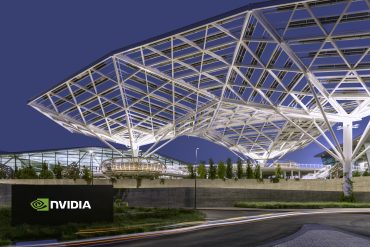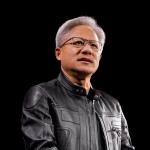
Nvidia Overtakes Microsoft as World's Most Valuable Public Company
6 minute read

Nvidia’s AI chip success and robotics expansion drive market value to $3.77 trillion as investors embrace tech transformation
Key Takeaways
- Nvidia reclaims $3.77 trillion market cap crown as shares surge 4% to all-time high of $154.31, surpassing Microsoft and Apple to become world’s most valuable public company.
- Robotics and autonomous vehicles represent multi-trillion dollar opportunity beyond AI chips, with CEO Jensen Huang targeting billions of robots and hundreds of millions of autonomous vehicles powered by Nvidia technology.
- Automotive and robotics division posts 72% year-over-year growth reaching $567 million in quarterly sales, though still representing just 1% of total company revenue.
Introduction
Nvidia has reclaimed its position as the world’s most valuable publicly traded company, with shares jumping over 4% to close at an all-time high of $154.31. The surge pushes the AI chipmaker’s market capitalization to $3.77 trillion, surpassing Microsoft at $3.66 trillion and Apple at $3.01 trillion.
CEO Jensen Huang outlined the company’s expanded vision beyond artificial intelligence during Wednesday’s shareholder meeting. He identified robotics and autonomous vehicles as multi-trillion-dollar growth opportunities that will drive Nvidia’s next phase of expansion, as reported by CNBC.
Key Developments
Huang emphasized that Nvidia has evolved from a pure chip manufacturer into what he describes as an “AI infrastructure” or “computing platform” provider. The company now offers complementary technologies including software, cloud services, and networking chips alongside its dominant AI processors.
The transformation includes a strategic restructuring completed over a year ago, merging automotive and robotics departments into a single business unit. This division reported quarterly sales of $567 million in May, representing approximately 1% of total company revenue but showing robust 72% year-over-year growth.
Nvidia has forged key partnerships to advance its robotics ambitions. The company recently disclosed a collaboration with Hexagon for industrial humanoid robots and continues working with Cosmos, a foundation model platform optimized for robotics and autonomous vehicles. These partnerships leverage Nvidia’s integrated ecosystem of hardware, software, and AI models.
Market Impact
Nvidia’s stock performance reflects investor confidence in the company’s diversification strategy. The shares have more than doubled over the past year as part of a broader surge in AI-related investments. Revenue reached $130.5 billion in the latest fiscal year, driven primarily by unprecedented demand for AI infrastructure.
The company’s Chinese operations generated $17.1 billion in sales, representing over 13% of total revenue and marking a 66% increase from the previous year. This growth persists despite U.S. government restrictions on AI chip exports that initially threatened approximately $8 billion in second-quarter revenue.
Analysts anticipate continued momentum, projecting a 53% increase in AI chip sales to $200 billion this year. The sustained investment from major customers has helped offset earlier concerns about potential slowdowns in AI spending.
Strategic Insights
Huang positions autonomous vehicles as the initial large-scale commercial application of robotics technology. His vision extends beyond transportation to encompass manufacturing, healthcare, agriculture, and service industries powered by what Nvidia terms “physical AI.”
The company’s strategy centers on creating comprehensive solutions rather than standalone products. Nvidia’s Omniverse platform enables virtual testing of robot fleets before real-world deployment, while the Isaac GR00T Blueprint addresses the challenge of generating training data for humanoid robots through synthetic datasets.
Market dynamics support Nvidia’s robotics pivot. Labor shortages, aging populations, and immigration restrictions are driving demand for automated solutions across global industries. The economics of automation become increasingly attractive as traditional workforce challenges intensify.
Expert Opinions and Data
“We’re working towards a day where there will be billions of robots, hundreds of millions of autonomous vehicles, and hundreds of thousands of robotic factories that can be powered by Nvidia technology,” Huang stated during the shareholder meeting. He declared this “the decade of autonomous vehicles, robotics, autonomous machines” at the Viva Tech conference in Paris.
Industry projections validate Nvidia’s ambitious timeline. Citigroup estimates 1.3 billion AI-enabled robots by 2035, expanding to 4 billion by 2050. The humanoid robot market alone could reach $7 trillion by 2050, though analysts note that less than 5% of factory robots entering service in 2025 will be humanoid designs.
Analysts at Forrester and Citigroup view Nvidia’s Cosmos and Omniverse platforms as potentially pivotal for widespread adoption of cognitive and physical automation. However, some maintain skepticism about near-term humanoid robot prevalence, expecting most immediate applications to focus on specific industrial tasks.
Conclusion
Nvidia’s market leadership reflects both its current AI chip dominance and investor confidence in its robotics expansion strategy. The company has successfully positioned itself as an infrastructure provider for the next wave of industrial automation, moving beyond hardware to offer integrated solutions spanning software, cloud services, and development platforms.
The convergence of technological capability, market demand, and economic necessity creates favorable conditions for Nvidia’s robotics ambitions. While autonomous vehicles and industrial applications lead current deployment, the company’s comprehensive approach positions it to capitalize on broader automation trends across multiple sectors.








